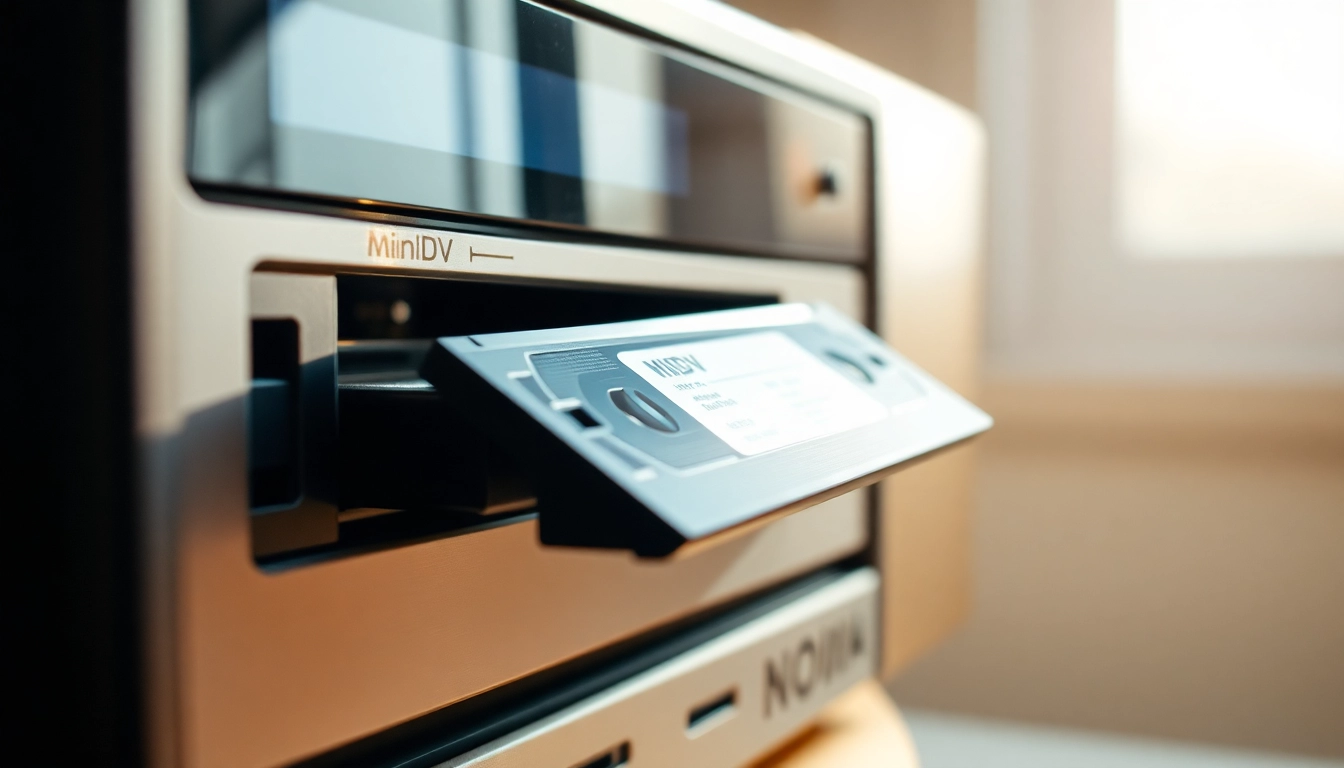Introduction to MiniDV to Digital Conversion
MiniDV tapes, first introduced in 1995, marked a significant evolution in video recording technology. They provided a compact format that allowed consumers and professionals alike to capture high-quality videos. However, with the rapid advancement of digital media, these tapes have become less accessible as technology evolves. Thus, converting MiniDV tapes to digital formats is crucial to preserving these valuable memories. This article will provide a detailed examination of the MiniDV to digital conversion process, including the benefits of digitization, methods available, and best practices for ensuring the longevity and accessibility of your digital files. For further assistance, consider visiting Minidv to digital services that offer expert support.
Understanding MiniDV Tapes
MiniDV tapes recorded video in Digital Video (DV) format, utilizing a high-quality compression technique to store digital audio and video data. Each tape typically holds up to 60-90 minutes of footage in a size that is remarkably compact. This advantage made MiniDV a popular choice for both consumers using camcorders and professionals in the filmmaking industry.
The MiniDV format uses a 1/6-inch magnetic tape, which stores video information in the form of digital data. This format was convenient for its time, but like all technology, it has its limitations. Tapes can degrade over time due to physical wear and environmental factors, leading to potential loss of valuable footage. Hence, understanding the nature of these tapes is essential for anyone looking to preserve their video memories.
The Need for Digitization
As technology progresses, media formats become obsolete. MiniDV tapes, once revolutionary, are now often relegated to storage boxes, potentially losing their content as the hardware to play them, such as MiniDV camcorders, becomes rarer. The need for digitization arises not only to preserve these memories but also to enable easier access and sharing.
Digital formats offer numerous advantages over analog tapes, including:
– Enhanced Accessibility: Digital videos can be played on a wide variety of devices, including computers, tablets, and smartphones.
– Space Efficiency: Digital files save physical storage space that would otherwise be consumed by tapes.
– Editing Capabilities: Digitized footage can be easily edited and repurposed, offering creative possibilities that are challenging to achieve with tape.
– Longevity: While MiniDV tapes can degrade over time, digital files can be backed up and stored in various formats, ensuring their longevity.
Overview of Conversion Methods
Converting MiniDV tapes to digital can be achieved through several methods, each with its pros and cons. The three primary approaches include dedicated video converters, software solutions for DIY conversion, and professional transfer services.
– Dedicated Video Converters: These devices are designed specifically for converting video formats and are often user-friendly.
– Software Solutions: For tech-savvy individuals, software solutions allow for capturing and converting video using a computer; however, they can be more time-consuming and may require specific equipment.
– Professional Transfer Services: Utilizing a service can save time and ensure high quality but typically comes at a cost.
In the following sections, we will explore these methods in depth, providing clear guidance on their use and effectiveness.
Best Methods for Converting MiniDV to Digital
Using Dedicated Video Converters
Dedicated video converters are standalone devices that allow users to transfer MiniDV tapes to digital formats easily. These devices typically come equipped with inputs for MiniDV tape players and outputs for USB or HDMI connections to a computer or external storage.
Advantages:
– Ease of Use: Most dedicated converters are designed with simplicity in mind, often requiring minimal setup.
– Quality Preservation: High-quality converters can maintain the integrity of the original footage without significant quality loss.
– Portability: These devices are generally compact, allowing for easy storage and transport.
Considerations:
– Cost: Depending on the model and features, dedicated converters can be a significant investment.
– Compatibility: Ensure the device supports your specific MiniDV tapes and desired output format (e.g., MP4, AVI).
Popular Models:
– ClearClick Video to Digital Converter 2.0: This device is known for its reliability in transferring various input types, including MiniDV tapes.
– Elgato Video Capture: A versatile option for those wanting to digitize different video formats without needing multiple devices.
Software Solutions for Home Conversion
If you prefer a DIY approach, several software solutions allow for digitizing your MiniDV tapes using a computer. This method often requires a compatible MiniDV camcorder or a tape deck, a FireWire connection, and video capture software.
Step-by-Step Guide:
1. Equipment Setup: Connect the MiniDV camcorder to your computer using a FireWire cable.
2. Install Video Capture Software: Popular software options include Adobe Premiere Pro, iMovie for Mac users, or open-source options like OBS Studio.
3. Capture the Video: Open the software and set it to capture mode. Play the MiniDV tape, and the software will record the output in real-time.
4. Save the File: Once the video captures, save it in your preferred format.
Challenges:
– Time-consuming: The process can take a while, especially if you have multiple tapes.
– Technical Issues: Users may encounter driver or compatibility issues with the software and their hardware.
Professional Transfer Services
For those who prefer a hassle-free experience, professional transfer services provide an excellent solution for converting MiniDV tapes to digital formats. Companies like Legacybox or Southtree specialize in digitizing various media formats, including MiniDV.
How It Works:
1. Send Your Tapes: Mail your MiniDV tapes to the service provider.
2. Conversion: They process and convert your tapes using professional-grade equipment.
3. Receive Digital Files: You typically receive your digitized content on a USB drive, DVD, or directly to a cloud service.
Advantages:
– Convenience: Eliminate the technical hassle of converting the tapes yourself.
– Professional Quality: Ensure high-quality conversion with experienced technicians.
Cost:
While prices vary, expect to pay between $15 to $30 per tape, depending on the service provider and the options selected for the final output.
Step-by-Step Process of Converting MiniDV
Gathering Necessary Equipment
Before beginning the conversion process, gather all necessary equipment. You will require:
– A MiniDV camcorder or playback device: Ensure it is functioning correctly.
– A computer with sufficient storage: Depending on the duration of your tapes, ensure your system can handle large file sizes.
– FireWire cable or USB cables: This depends on the equipment you plan to use.
– Video capture software (if choosing the software solution).
Preparing Your MiniDV Tapes
Inspect your MiniDV tapes for any signs of damage or degradation. If the tape shows wear, consider professional services that offer reel repair. Additionally, ensure the tapes are clean by gently removing dust or debris from the casing.
Executing the Conversion Process
1. Connect Equipment: Connect your MiniDV camcorder to your computer using the selected interface.
2. Set Up Software: Launch your video capture software and set it to the input option corresponding to your device.
3. Initiate Capture: Play the MiniDV tape, and begin capturing the footage through the software.
4. Monitor Quality: Keep an eye on the output quality. Adjust settings if necessary to ensure the best results.
5. Save and Backup: After capturing, save the files in multiple formats if desired, and create backups on external drives or cloud services to prevent loss.
Common Challenges in MiniDV to Digital Conversion
Quality Loss During Conversion
One of the common concerns with digitizing MiniDV tapes is the potential for quality loss. Converting from tape to digital can lead to degradation if not done correctly.
Solutions:
– Use high-quality equipment and conversion methods to minimize loss.
– Preserve the original output format whenever possible.
Technical Issues with Recording Equipment
Users may encounter device malfunctions, outdated drivers, or connection issues during conversion.
Solutions:
– Regularly update device drivers and software interfaces to ensure compatibility.
– Consult forums and user guides for troubleshooting tips specific to your setup.
Solutions to Common Problems
Being aware of common challenges can help prepare you for a smoother conversion process. Keeping your software and hardware up to date, using reliable conversion machines, and recognizing potential hardware issues can make the process simpler.
Preserving Your Digital Files
Best Formats for Saved Digital Content
When converting MiniDV tapes to digital, the format selected for saving is crucial. Common formats for video files include:
– MP4: Highly compatible with various devices and platforms; it offers a good balance between quality and file size.
– AVI: While higher quality, the file sizes can be large, making it less ideal for casual sharing and storage.
– MOV: Preferred by Apple users, particularly for editing in software like Final Cut Pro.
Cloud Storage vs. Local Storage
Deciding where to store your digitized content is essential for ensuring longevity.
– Cloud Storage: This option offers the advantage of access from anywhere and protection against physical damage. Services such as Google Drive, Dropbox, and dedicated video storage platforms can help provide secure storage.
– Local Storage: Storing on a local drive or external hard drive offers fast access and control over your files. Ensure regular backups to avoid data loss due to drive failure.
Ensuring Longevity of Your Digital Files
To ensure your digital videos last for years:
– Regular Backups: Use multiple storage methods (cloud and local external drives).
– Periodic Checks: Regularly check your files for data integrity and ensure that the formats remain compatible with current technology.
– Update Storage Solutions: As file formats and storage technology evolve, update your storage methods to prevent obsolescence.
Conclusion
Converting MiniDV tapes to digital format is an invaluable step in preserving cherished memories for future generations. By understanding the conversion methods, preparing properly, and ensuring the longevity of digital files, you can enjoy your favorite videos in a format that’s easily accessible, shareable, and cherished. Whether you choose to go the DIY route or enlist professional help, the effort will certainly pay off, ensuring that your memories remain safe and sound for years to come.



